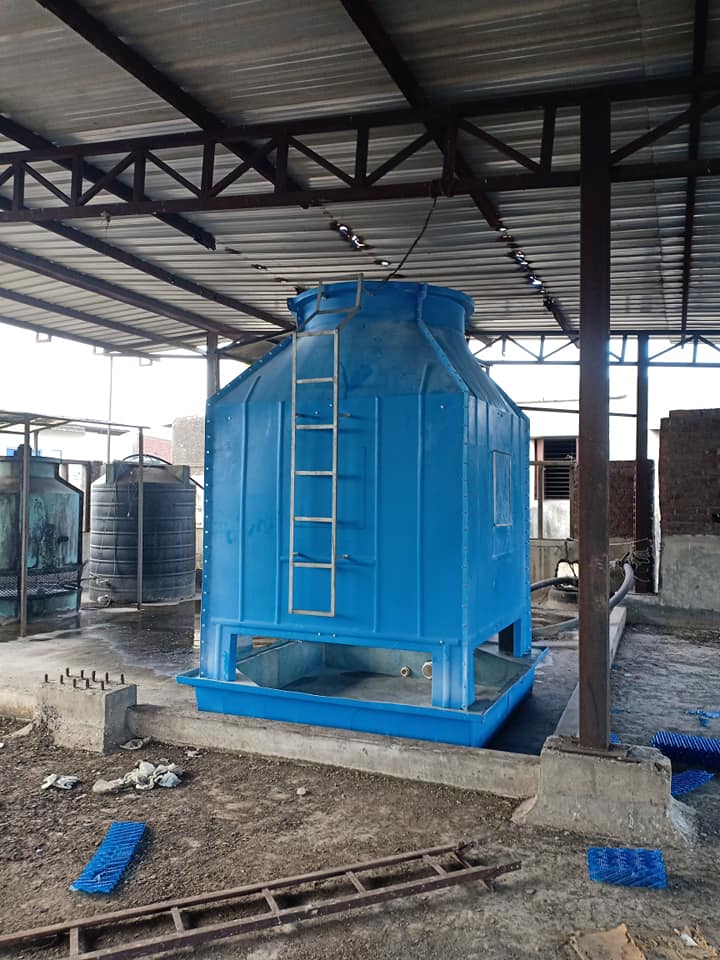Use of Cooling Towers in the Pulp & Paper Industry
Cooling towers play a critical role in pulp and paper manufacturing, where precise temperature control is essential for chemical processes, equipment protection, and energy efficiency. The industry’s high thermal loads and corrosive environments demand specialized cooling solutions.
1. Key Applications in Pulp & Paper Production
A. Process Cooling
- Digester Cooling: Controls temperatures in chemical pulping (Kraft/Sulfite processes)
- Bleach Plant Cooling: Maintains optimal conditions for chlorine dioxide stages
- Paper Machine Cooling: Regulates temperatures in drying sections and calenders
B. Chemical Recovery
- Cools flue gas scrubbers in recovery boilers
- Controls temperatures in evaporator condensers
- Maintains lime kiln operations
C. Equipment Protection
- Cools hydraulic systems in pulp presses
- Prevents overheating in refiners and grinders
- Maintains bearing temperatures in large rollers
2. Specialized Cooling Tower Requirements
| Challenge | Industry-Specific Solution |
| High Fiber Loads | Self-cleaning nozzles + debris filters |
| Chemical Exposure | FRP construction or 316L stainless steel |
| Variable Loads | VFD-controlled fans for batch processes |
| Steam Condensation | Direct contact condensers for heat recovery |
Preferred Tower Types:
- Crossflow Design: Handles high particulate loads
- Closed-Circuit Towers: For chemical-laden streams
- Hybrid Systems: Combine evaporative and air cooling
3. Unique Process Considerations
A. Black Liquor Cooling
- Requires corrosion-resistant materials (titanium/duplex steel)
- Specialized scaling inhibitors for sodium salts
B. White Water Systems
- Manages water reuse in paper machines
- Biofilm control through ozonation
C. Energy Integration
- Heat recovery for pre-heating process water
- Condensate return systems for boilers
. Maintenance & Optimization
Critical Practices:
- Daily: Inspect spray nozzles for fiber clogging
- Weekly: Test water chemistry (pH, conductivity)
- Monthly: Clean fill media and basin
- Annually: Inspect mechanical components
Advanced Solutions:
- Automated biocide dosing systems
- Real-time scaling potential monitoring
- AI-driven performance optimization
5. Environmental Compliance
Key Regulations:
- EPA Effluent Guidelines for Pulp & Paper
- Zero Liquid Discharge (ZLD) requirements
- Best Available Techniques (BAT) for water reuse
Sustainability Measures:
- Closed-loop water systems
- Waste heat utilization
- Biodegradable treatment chemicals
1. How Cooling Towers Work in Commercial HVAC
The Basic Cooling Cycle
- Chillers remove heat from building air (via chilled water loops)
- Hot refrigerant transfers heat to condenser water (90-100°F)
- Cooling tower cools condenser water through evaporation
- Cooled water (75-85°F) returns to chillers to repeat cycle
Key Components
- Fill media (increases water-air contact)
- Drift eliminators (reduces water loss)
- Fans (induced or forced draft)
- Water distribution system
- Basin and filtration system
2. Types of Cooling Towers for Commercial Use
| Type | How It Works | Best For | Advantages |
| Open Circuit | Water directly exposed to air | Large office buildings | Lowest initial cost |
| Closed Circuit | Cooling fluid in sealed coils | Hospitals, data centres | No contamination risk |
| Crossflow | Air flows horizontally across falling water | Mid-rise buildings | Energy efficient |
| Counterflow | Air moves upward against water flow | High-efficiency needs | Compact footprint |
| Hybrid | Combines wet/dry cooling | Water-restricted areas | Reduces water use |
3. Sizing Considerations for Commercial Projects
Key Factors:
- Building square footage
- Occupancy density
- Climate zone (wet bulb temperature)
- Chiller tonnage
- Water availability
Rule of Thumb:
1 ton of cooling = ~3 GPM condenser water flow
(500-ton chiller → ~1,500 GPM cooling tower)
4. Energy Efficiency Strategies
Modern Best Practices:
◉ Variable Speed Fans: Adjust to load requirements (30-50% energy savings)
◉ Water Treatment: Prevents scaling/fouling (maintains 5-10°F approach)
◉ Heat Recovery: Reuses waste heat for domestic hot water
◉ Smart Controls: IoT-enabled performance optimization
Efficiency Metrics:
- Approach: Difference between cold water temp and wet bulb temp (ideal: 5-7°F)
- Range: Difference between inlet/outlet water temps (typical: 10-15°F)
Maintenance Requirements
Critical Tasks:
- Daily: Check water levels and pump operation
- Weekly: Inspect drift eliminators and fill media
- Monthly: Test water quality (pH, conductivity)
- Quarterly: Clean basins and check mechanical components
- Annually: Full system inspection and belt adjustment
Common Issues:
- Scale buildup (reduces efficiency by 15-20%)
- Legionella growth (requires biocide treatment)
- Fan/motor wear (vibration analysis recommended)
6. Cost Analysis
| Cost Factor | Open Tower | Closed Tower |
| Initial Cost | $150-$300/ton | $300-$600/ton |
| Water Use | 3-5 GPM/ton | 1-2 GPM/ton |
| Energy Use | 0.1-0.2 kW/ton | 0.15-0.3 kW/ton |
| Lifespan | 15-20 years | 20-25 years |
7. Emerging Technologies
The Future of Commercial Cooling:
- Magnetic Water Treatment: Reduces chemical use
- Nanocoated Fill Media: Improves heat transfer
- AI-Powered Optimization: Real-time performance tuning
- Green Roof Integration: Combines with landscaping
Conclusion
For commercial buildings, cooling towers offer the most cost-effective solution for large-scale heat rejection when properly selected and maintained. Key decision factors include:
- Water availability (open vs closed vs hybrid)
- Energy efficiency goals (VFDs, smart controls)
- Maintenance capabilities (water treatment requirements)
- Space constraints (modular vs field-erected)
Pro Tip: For new constructions, consider waterside economizers that use cooling towers for free cooling in winter months, reducing chiller runtime by 30-50%.Need help selecting a system? Match your building’s tonnage, water quality, and efficiency targets with the optimal tower configuration.
